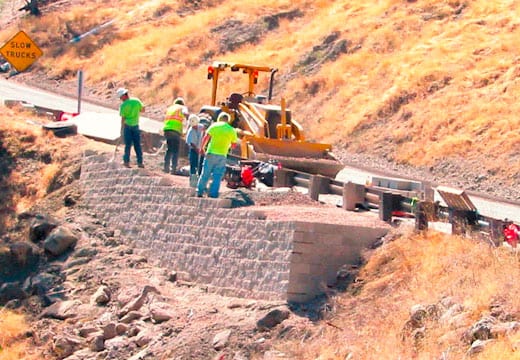





The Calpine Corporation operates a state-of-the-art, eco-friendly geothermal power generation plant just east of Northern California’s famous wine country. This facility covers thousands of acres and depends on a network of rugged mountain roads for maintenance, new construction, and general operations. The plant property is accessed from the west by Geysers Road and the east by Socrates Mine Road.
Calpine contacted GeoStabilization International®, a geohazard mitigation expert performing engineered soil repairs, to repair a section of Socrates Mine Road subjected to a shoulder-damaging slip-out. In addition to the damaged shoulder, the over-steep head scarp caused by the slip threatened the road’s stability. Calpine not only required an economical fix; they also wanted GeoStabilization to keep the road open during the repair and build an over-wide shoulder to accept future pipeline supports. GeoStabilization’s remediation design included a combination of SuperNail® soil anchors, reticulated ScourMicropiles™, and the Geosynthetically Confined Soil® (GCS®) technology, one of GeoStabilization’s soil stabilization innovations, as a retaining wall to widen the road’s shoulder.
Working from the road’s outboard lane to safely allow traffic to pass the site, the crews began drilling the soil nails horizontally into the slope’s scarp to stabilize its front face. Once complete, ScourMicropiles™ were installed vertically into the slope to conclude the retaining wall repair. Then, the crews built a Geosynthetically Confined Soil® (GCS®) wall atop the micropiles to provide a solid road foundation and robust platform for placing future pipeline supports.
Calpine reported that the solution successfully repaired the site for less than half the cost of traditional repair techniques with the added benefit of uninterrupted traffic flow.
Mechanically Stabilized Earth (MSE) walls and GCS® walls share many of the same characteristics, including:
The MSE wall structure consists of layers of alternating compacted backfill and soil reinforcement fixed to the wall facing. The wall’s stability results from the tension between the backfill and soil nail reinforcements, which creates a flexible construct that withstands significantly heavy loads. An MSE wall relies on the reinforcement mechanism, using grids that act as tiebacks.
In comparison, a GCS® wall differs from an MSE wall because its reinforcement materials confine the soil rather than interact with the facing and supporting elements. GCS® walls use closely spaced reinforcement material that provides uniform soil confinement throughout each layer. Adequate compaction is vital to prevent GCS® walls from failing.
For over twenty years, our teams have been mitigating landslides and providing residential slope stabilization, slope monitoring, slope protection, and landslide prevention services. Contact GeoStabilization International® at 855-579-0536 to learn how to utilize our geohazard mitigation services for your geotechnical application.
If you are interested in a no-obligation site visit to determine if our services fit your geohazard mitigation needs, call us at 855-579-0536 or fill out our contact form.